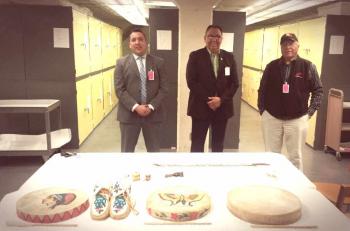Image Caption
By Shari Narine
Windspeaker Contributor
WABASCA, Alta.
The completion of renovations on an old Bigstone Cree band office that also served as the public works office in Wabasca, Alta. is the first step toward bringing home artifacts that are currently held in the Royal Alberta Museum (RAM) in Edmonton.
In April, members of the Wabasca and Area Museum Society met with representatives from RAM to open discussions.
“It’s important to bring these items home, especially for the families,” said Mike Beaver, president of the Wabasca museum society.
At this point, nine items are being discussed, said RAM executive director Chris Robinson. Six of the items were purchased—the first item purchased from a shop in May 1966—and three were donated by individuals. They were all received by RAM between 25 to 50 years ago. The items include hand drums, moccasins, and necklaces.
What’s being discussed, said Robinson, is not repatriation, but a long-term loan. According to provincial government policy, repatriation only pertains to ceremonial or sacred objects, such as the work RAM began with the Blackfoot Confederacy in 2000.
None of the Wabasca area items are ceremonial or sacred objects.
“We are happy to go through a loan process to have these materials on display at their museum,” said Robinson. He pointed out that such a loan agreement was struck with the Chief Poundmaker Historical Centre recently.
The loan agreement would see the materials go from RAM to be displayed in Wabasca on a long-term basis. During that time frame, the artifacts may come back to RAM for a condition assessment and necessary conservation and then would be returned to the Wabasca museum.
The efforts of the Wabasca museum society have received letters of support from MPs Arnold Viersen (Peace River-Westlock) and David Yurdiga (Fort McMurray-Cold Lake).
“It is very important to recognize the importance of these artifacts to be displayed in their newly-renovated museum,” wrote Yurdiga. "These cultural treasures are more than artifacts but a(n) integral part of the community and their ancestry.”
However, at this point, said Beaver, the Wabasca museum society still has work to do in the building.
The last four- to five-months, contractors undertook structural renovations to the building, including replacing numerous floor joists damaged by moisture, getting rid of mould, and upgrading plumbing and electricity.
“They made it beautiful. Everything in there is just like new,” said Beaver.
Now the focus needs to turn to requirements for security and the appropriate display cases in order for the items to be displayed locally. For that, said Beaver, more funding is necessary.
“We are a poor, poor organization, just starting. We only have a few dollars,” he said.
Approximately $100,000 was spent on renovations, with about two-thirds of the funding coming through Bigstone Cree Nation’s trust fund, and the remainder from the Municipal District of Opportunity.
Robinson said his staff will make themselves available this summer to travel to the Wabasca museum and give advice on the necessary steps to bring the local museum up to par.
Meanwhile, RAM is in the process of opening its own doors, which Robinson said will happen later this year, although he would not specify a month. A new building was constructed for the museum in downtown Edmonton.
Since 2014, Robinson said RAM has been working with an Indigenous Content Advisory Panel, consisting of 24 members who have “guided us in the stories that we can tell and the objects that we should be including in those displays.”
The new RAM will not have a separate Indigenous gallery. Instead, Indigenous content will be interwoven throughout a 30,000-square-foot gallery dedicated to Alberta’s cultural history.
“One of the messages that came out very clearly for us early in this process was the importance of Indigenous language as a component of culture,” said Robinson. To that end, not only will some interpretative plaques include Indigenous languages, but so, too, will the film pieces.
Robinson also notes a small welcome area in the new museum will recognize the traditional meeting ground of Treaty 6 territory and a changeable art piece will always be the work of Indigenous artists.

